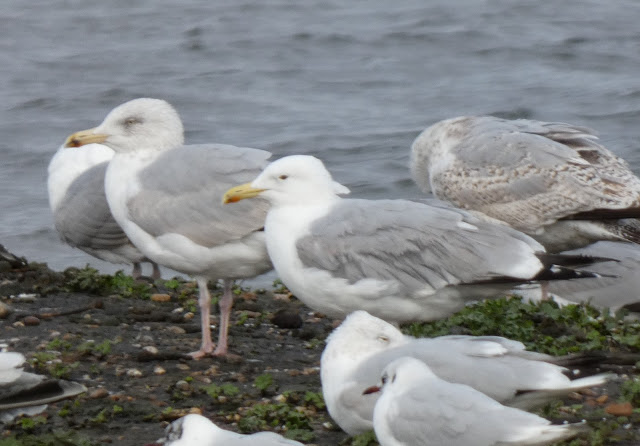Wildlife sightings for 6th July 2014
3 Little Ringed Plover - pair still at nest when one adult was chased off and around the scrape by a juvenile Black-headed Gull. The other adult stepped in to nest defence duties and the gull soon lost interest. Another adult on the main lake.
2 Ruddy Duck - males, main lake
Great Crested Grebe chicks on adult's back on reservoir lagoon
3 juvenile Green Woodpecker - at various places around the reserve
1 Treecreeper - seen by Explore bird feeders
1 juvenile Pied Wagtail - main lake
1 Blackcap - singing on west bank
Additional sighting from yesterday:
1 Red Kite - flew N at 11:45 a.m.
June/July bird highlights: Hobby, Red Kite, Oystercatcher, Black-tailed Godwit, Green Sandpiper, Little Ringed Plover, Ringed Plover, Mediterranean Gull, Kittiwake, Yellow-legged Gull, Kingfisher, Lesser Whitethroat.
Common Tern are still nesting with the Black-headed Gulls on the purpose-built rafts out on the main lake and reservoir lagoon. Whitethroat, Cetti’s Warbler, Garden Warbler, Reed Warbler, Sedge Warbler and Chiffchaff are among the many breeding birds holding territory and with young around the reserve. Recently Green Sandpipers have been feeding on the marsh and scrape, along with Little Ringed Plover. Small numbers of Teal and Shoveler, now going into eclipse plumage, have appeared on the wader scrape towards the end of June.
Flowering plants: Black Medick, Buckthorn, Cut-leaved Crane’s-bill, Dog-rose, Globeflower, Greater Celandine, Horseradish, Meadow Clary, Raspberry, Yellow Iris, Common Stork’s-bill, Goat’s-beard, Hairy Tare, Hoary Cress, Adder’s-tongue fern, Common Spike-rush, Dogwood, Germander Speedwell, Glaucous Sedge, Ground Ivy, Hedgerow Crane’s-bill, Meadow Foxtail, Red Clover, Round-leaved Crane’s-bill, Solomon’s Seal, Star-of-Bethlehem, Tuberous Comfrey, White Campion, White Water-lily, Beaked Hawk’s-beard, Bird Cherry, Bistort, Bluebell, Bogbean, Bugle, Cleavers, Clustered Mouse-ear, False Fox-sedge, Field Forget-me-not, Garlic Mustard, Greater Stitchwort, Greater Tussock-sedge, Guelder-rose, Lesser Pond-sedge, Meadow Buttercup, Ox-eye Daisy, Pendulous Sedge, Red Campion, Red Valerian, Salad Burnet, Smooth Meadow-grass, Sweet Vernal-grass, Whitebeam, Wood Avens.
Butterflies: White Admiral (first record), Green Hairstreak, Orange Tip, Small White, Peacock, Speckled Wood, Common Blue, Holly Blue, Green-veined White, Large White, Small Tortoiseshell, Comma, Red Admiral.
Moths: Elephant Hawk-moth, Lime Hawk-moth, 2 Treble Lines, Heart & Dart, and 3 Light Brocade all caught in overnight moth trap at Explore playground; Cinnabar Moth.
Dragonflies: Hairy Dragonfly, Common Blue Damselfly, Blue-tailed Damselfly, Black-tailed Skimmer, Emperor Dragonfly, Azure Damselfly, Large Red Damselfly.
Hoverflies: Melanostoma scalare, Epistrophe eligans, Riponnensia splendens, Eristalis pertinax, Eristalis intricarius, Myathropa florea, Helophilus pendulus.
Other insects: Honey Bee, Buff-tailed Bumblebee, Early Bumblebee, Common Carder Bee, Hairy-footed Flower-bee, Common Green Shield-Bug, Large Red Damselfly, 7-Spot Ladybird, Harlequin Ladybird.
Reptiles: Slow Worms on banks, adult Grass Snakes occasionally seen swimming in water, Common Lizards basking on bridges, hides, log piles etc.
Amphibians: male and female Smooth Newts mostly found in the South Route ponds; Marsh Frogs now very vocal across the reserve, with best places in wildside ponds and entrance lake. Young Marsh Frogs have been spotted in the wildside ponds (end of June).
Bats: The third bat survey of the season on 15th May found a couple of locations with constant Soprano Pipistrelle activity (Wildside, Peacock Tower). Nathusius’ Pipistrelle appeared on both transect routes, but constant activity was encountered around the Peacock Tower. Leisler’s Bat had a period of constant activity in the Reedbed area too. There were 7 species of bat recorded, with the following activity levels: Soprano Pipstrelle >> Nathusius’ Pipistrelle > Leisler’s Bat >> Noctule > Daubenton’s Bat > Serotine; also a Common Pipistrelle detected later on after survey.



